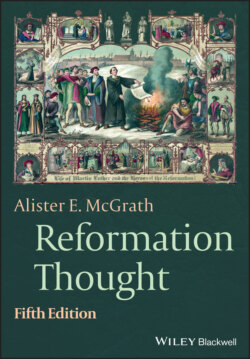Читать книгу Reformation Thought - Alister E. McGrath - Страница 10
How to Use This Book
ОглавлениеThree words sum up the aims and approach of this textbook: introduce; explain; contextualize. First, the book aims to introduce the leading ideas of the European Reformation, and the individual thinkers who introduced and developed them. Like a sketch map, it outlines the main features of the intellectual landscape of this age, providing suggestions for further reading which will allow its readers to add finer detail later. Second, the book aims to explain these ideas. It assumes that its readers know little about the Christian theology which underlies the Reformation, and explains what terms such as “justification by faith” mean, and why they are of religious and social relevance. Third, it aims to contextualize these ideas by setting them in their proper intellectual, social, and political context. That context includes such great intellectual movements as humanism and scholasticism, and the political and social realities of the imperial cities of the early sixteenth century.
So how should you use this book? How can you get most out of it? To answer this question, we need to look at its structure, which has two main parts.
1. The Context of the Thought of the Reformation
Following an introductory chapter, providing a sketch map of the great movements of reform and renewal which we today know as “the Reformation,” identifying its main elements and some of the issues it raised, the next four chapters of the book set the historical and intellectual context for the great debates of the Age of Reformation. The second chapter provides an overview of some of the cultural and social issues which emerged in western Europe during the late Middle Ages, which are thought to have contributed to the development of local reforming movements within the western church from the 1490s, particularly in Spain and Italy.
We then turn to consider the two major intellectual movements that are known to have had a significant impact on early sixteenth century religious thought – Renaissance humanism and medieval scholasticism. The third and fourth chapters of this book consider the leading ideas and representative figures from this period, considering their intellectual backgrounds, religious agendas, and contributions to the Reformation debates. The fifth chapter offers brief biographical sketches of some of seven significant figures of the Reformation, in preparation for the sustained engagement with the ideas of the movement in the second part of the work.
2. The Core Themes of Reformation Thought
The second major section consists of six chapters (6–11) which engage the main themes of Reformation thought – such as the authority and interpretation of the Bible, the doctrine of justification by faith, and the nature of the church. In each case, considerable care is taken to explain the positions of a range of contributors, including Lutheran, Reformed, Anabaptist, and Catholic. At several points, significant English contributions to these debates are noted, referencing key English writers such as William Tyndale and Thomas Cranmer. Although earlier editions included a chapter dedicated to the thought of English writers, their dependence on their continental counterparts made it more appropriate to integrate them into the thematic discussion of issues, and thus allow their significance to be better understood. A final chapter (Chapter 12) considers how the ideas of the Reformation age spread internationally, and their impact on the historical process.
So how should you use this book? My correspondence with users of earlier editions suggests that most fall into one of two groups. I shall briefly describe these two broad categories of readers, and explain how each can get the most out of this textbook.
Some readers will want to go deeply into the thought of the Reformation period, understanding both its historical context and evolution and wider cultural and historical significance. They should read the book in its totality in the order in which the material is presented. This allows a cumulative and progressive approach to Reformation thought, in that each chapter can build on the foundations laid earlier. It is easier to understand the nature and significance of the theological debates of the age of Reformation if you know about their historical context.
Others, however, will want to master the key ideas of the Reformation, aiming to gain an understanding of their theological significance. For such readers, the historical and cultural context is not of pressing importance, and can be explored later. These readers should begin at Chapter 6, and end at Chapter 11. You will find discussion of certain points that reference earlier chapters – especially relating to Renaissance humanism and medieval scholasticism. You can either ignore these, or follow them through later. The work has been designed to allow you to understand the theological issues debated in the age of Reformation, without requiring a detailed historical knowledge of their background and context. You may also find it interesting to consider the longer-term significance of these ideas, which is discussed in Chapter 12.
This work also includes a series of appendices that deal with difficulties which experience suggests most students encounter as they read works relating to the Reformation. What do these abbreviations mean? How can I make sense of those references to primary and secondary sources? What does “Pelagian” mean? Where should I go to find out more about the Reformation? These questions and others are dealt with at length, making this book especially valuable to those new to the field. I assume that the reader speaks no language other than English, and all Latin quotations or slogans are therefore translated and explained. Although the text of the work draws extensively upon foreign language scholarship, I have woven this seamlessly into the analysis, and limited my bibliographies to works that are available in English.
